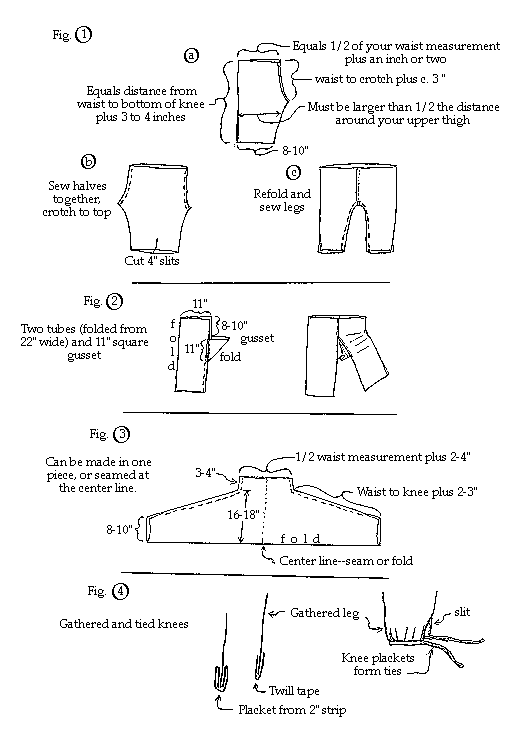
BRAIES
AND
TROUSERS
1/4/04
|
|
|
|
|
|
|
|
|
|
|
Braies are short linen trousers over which are worn the hosen (long stockings). No medieval braies are known to exist today, but illustrations show that they were somewhat baggy, with a sort of "diaper" effect in the crotch, and the knees were gathered and tied. There was presumably a drawstring at the waist, and sometimes it seems that the waist was made extra high, and the excess fabric rolled down over the drawstring. A pair of points (laces) sewn inside the braies and hanging out over a waist roll would make effective and comfortable suspension for one's hosen. Whether the waist is rolled or not, you will need some sort of points or loops to fasten the hosen.
At the
outside
of each knee, make a 4" slit (or leave the seam unsewn) and hem the
edges.
Gather the fabric to match the circumference of your leg just
below
the knee, and sew it to the middle third of a knee band or placket 36"
long or more--the ends of the band serve as ties. (see fig. 4)
In the
absence
of any firm evidence, all braies patterns include some guesswork.
Any of the styles shown here will have tied knees and a waist
drawstring.
Add 3 or 4 inches to the height of the waist if you want a waist roll.
Fig. 1. The first pattern is the basis for most post-medieval trousers, and can be made from about 1.5 yards of linen. Cut out 2 halves to the dimensions shown (a) and sew together from crotch to top (b). Open and refold into a trouser shape and sew the inseams (c).
Fig 2. The second pattern consists simply of 2 tubes and an 11"-square gusset. It uses about 1 1/3 yards of linen, and won't leave a lot of oddly-shaped scraps. Sewing a gusset between two tubes is much easier to do than to describe, but you may want some experienced help.
Fig 3. These last braies are based on
traditional
Lappland trousers. They take about 2 1/2 yards of linen, but are
very easy to make. They also have the weird baggy crotch seen in
medieval illustrations--you will never split it! If you want to
experiment
first, grab an old bedsheet and spend about 15 minutes making a mock-up.

Scandanavians
and possibly some Saxons wore trousers, which can be made from the
braies
patterns. Simply lengthen the legs and make them fit your legs
(snug,
but not tight). The waist can have a drawstring or belt loops,
and
feet can be added from the hosen pattern.
If you only have trousers, they can be made to look more like hosen by
adding crossgarters or winingas (leg wraps)--see the Hosen
page for details.
Information on Braies from the Circa 1265 website: http://www.bumply.com/Medieval/braies.htm
Conjectural Mid-14th Century Braies by John Jordan, http://scamelee.freeservers.com/braies_personal.html
Inserting Gores and Gussets, http://www.vertetsable.com/goresgussets.htm
Viking Experience Kit Guides on Trousers, http://www.the-viking-expericence.co.uk/authenticity/basickit/basickit5.html
and Breeches(Braies), http://www.the-viking-expericence.co.uk/authenticity/basickit/basickit6.html
Making Chausses and Braies, http://www.randyasplund.com/browse/medieval/chauss2.html.
|
|
|
|
|
|
|
|
|
|
|